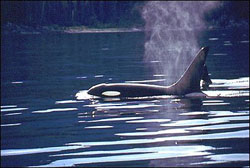The Laws of Ecology: "All things are interconnected.
Everything goes Differential Toxicity and Environmental Fates of Hexachlorocyclohexane Isomers Willett, K.L.; Ulrich, E.M.; Hites, R.A.
Pollution rides into the Arctic on the winds. When winter's bone-chilling polar air masses reach south into the U.S., Europe and Asia, they do more than close schools and strand motorists. These weather fronts also collect toxic air pollution from industrial and urban centers and then transport these poisons north to the land of the great white bears. For example, the amount of PCBs falling from the Arctic sky in snow, rain and dust are comparable to amounts falling on the Great Lakes. The amount of the chlorinated pesticide lindane dumped from the Arctic sky, however, is about 100 times higher than in the Great Lakes region.[86] Reasons for this surprising finding are unclear. Lindane: A
Review of Toxicity and Environmental Fate
(Ottawa: November 24, 1999) World Wildlife Fund Canada (WWF) today called on Health Minister Allan Rock to ban lindane, a persistent pesticide known for its toxicity to wildlife and humans. In support of its call, WWF submitted a comprehensive report, Lindane: A Review of Toxicity and Environmental Fate, documenting lindane’s hazards and presence in the environment, food, wildlife and human tissues. The report highlights the particular vulnerability of the Arctic to lindane. Given the strength of existing evidence about lindane’s risks, WWF also urged Mr. Rock to quickly conclude the "Special Review" of the pesticide which was initiated in December 1998. "There is no need for a prolonged process to gather more data," Julia Langer, Director of WWF Canada’s Wildlife Toxicology Program, said. "All the literature shows that lindane is persistent, bioaccumulative and toxic. Every person, animal and ecosystem, especially in the Arctic, contains lindane. This adds up to an unacceptable risk. But we can bring these levels down by banning lindane." Lindane: A Review of Toxicity and Environmental Fate, and a
backgrounder on lindane’s toxicity, alternatives and regulatory status are
available on request. Please email jbecka@wwfcanada.org. Lindane,
from Cornfields to the Atmosphere
If pollutants have a fairly long atmospheric lifetime (> 2 days) because
of their physicochemical properties, they may be transported by air masses over
long distances. The annual time series of alpha-HCH and gamma-HCH and their
ratio (Figure 2) provides us with information about North American sources of
lindane measured in the atmosphere at Villeroy, since lindane does not have the
same profile as the alpha-HCH isomer. In addition, back-trajectories (925 mb) of
air masses (Figure 3) in the periods before, during and after the highest
measured ratio of gamma-HCH and alpha-HCH (on May 20, 1992) at Villeroy show
that the source of lindane is primarily local (along the St Lawrence River
valley), since these isomers had travelled relatively little in the five days
prior to the period of maximum concentration. The fact that the atmospheric
lifetime of lindane is about four days supports this result. Lindane measured in
the atmosphere may be related to agricultural activities, namely corn seeding. Lindane, the y-isomer of hexachlorocyclohexane, is a
colorless, crystalline solid which is soluble in water. Lindane: Half Life BaP: Source: Howard et al (1991). Handbook of Environmental Degradation Rates Environmental Fate Evaluation of DDT, Chlordane and Lindane The
Effects Of Environmental Pollutants On North American Temperate Forests Biological
Markers of Water Pollution
A
web-based resource on contaminant analysis techniques, organochlorine
contaminant properties and sources, and the impact and extent of contamination
on Blue Whales in the St. Lawrence seaway, Metcalfe lab,
|
